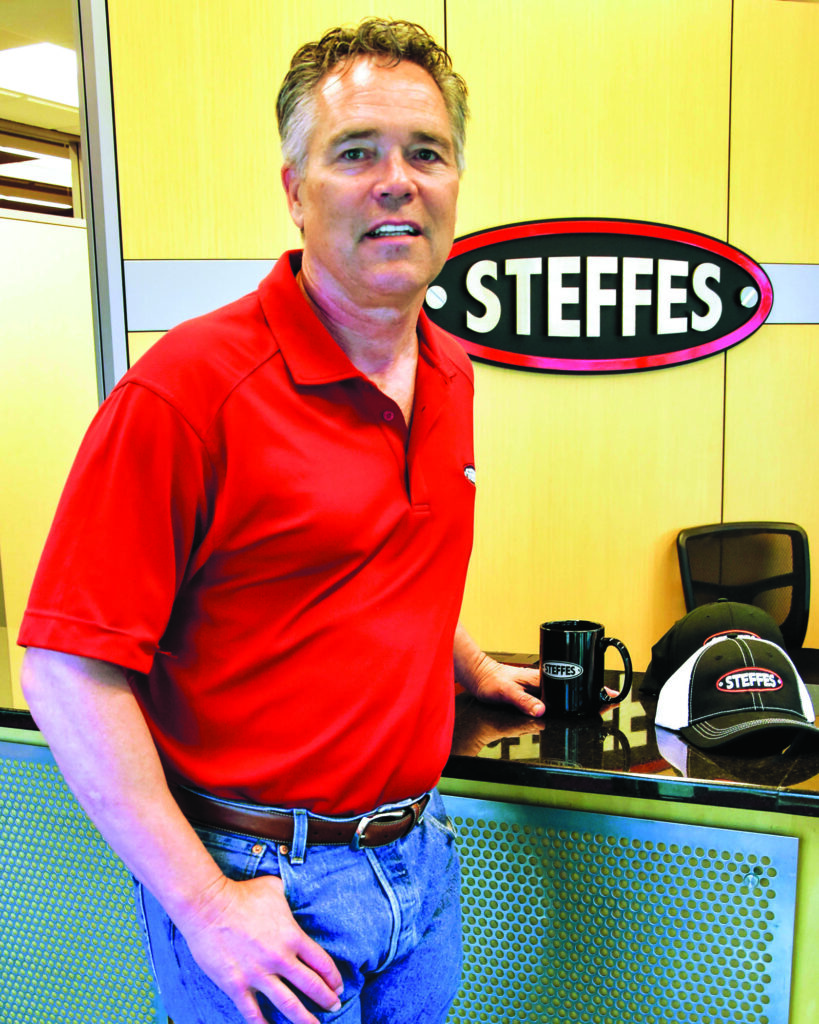
Steffes Auctioneers held its first live outdoor auction of the season this week at a farm south of Fargo. Land and equipment auctions have been taken place exclusively online, president Scott Steffes says, since coronavirus precautions ruled out face-to-face gatherings, but it’s nothing new: The company has been using the internet since 2009. (Photo/Nancy Hanson)
Nancy Edmonds Hanson
Scott Steffes says live-action auctions are back this week after an extended break of online-only sales.
A number of retiring farmers who had planned events with Steffes Auctioneers were forced to push back their dates during the first part of the 2020 auction season because of the coronavirus. “They want the traditional social aspect for their auctions,” the second-generation auctioneer reports. “They’re a lot like weddings or graduations – a chance to see all your friends and relatives show up for the day. They’re very significant events in those farm families. They mark the end of a legacy.”
After avoiding large gatherings in respect for North Dakota’s health guidelines, he says, now seems to be the right time to resume. “There’s a greater comfort level now,” he observes. “We feel we can safely do outdoor auctions while protecting everyone’s health. Social distancing is easy to do out on the farm.” The company’s clerks and cashiers will be set up with hand sanitizer per state guidelines. Masks will not be required.
The vast majority of scheduled auctions this spring converted to online-only events, thanks to the evolution of the auction business. Scott says his company, which celebrates its 60th anniversary this year, had moved toward contact-free online bidding long before the coronavirus arrived to complicate scheduling.
“We started online auctions more than 10 years ago, so rescheduling those events was a fairly easy process,” he says. “We moved in that direction because of demand among our buyers and sellers. Farmers are very tech-savvy. They’re always looking for ways to do something a little better, and they’re used to leveraging technology. So we listened to them. They were happy to find a way to avoid standing around all day at a live auction waiting to bid on only one or two pieces. Technology allows them to avoid the lines and the waiting, and bid on what they have an eye on from the comfort of their tractor cab, farm office or pickup.”
He calls it “the death of distance.” “It’s the single greatest advantage of online auctions. We’re able to attract long-distance bidders and avoid the cost of transporting and storing machinery to a central location until it’s sold.”
That wasn’t the case when Bob Steffes, his father, was bid-calling his first auctions around Arthur, North Dakota, back in 1960. In those days, competition among auctioneers was fierce; every little town had its own bid caller. The elder Effeteness’s first auction netted $5,500 in sales; in comparison, today’s gross hundreds of thousands and even millions. One old favorite perk is missing, though. Scott notes that the ladies group’s that once served lunch are long gone. “We used to get the most amazing pies in Hunter,” he reminisces.
His company began accepting internet bids as early as 1997, Scott says – a cumbersome process in those days of dial-up connections. Now even live auctions are actually a hybrid of buyers on the scene bidding against others who are online. Scott says at least 50% of live farm auction lots go to internet bidders. After moving ahead with all-online auctions in 2009, the Steffes Group watched attendance at live events peak and begin to diminish. Their annual Ag Iron event at the Red River Valley Fairgrounds set a record in 2012, with close to 2,000 in attendance and multi-millions in sales across seven auction rings. “We had 18 acres of machinery,” he reminisces.
Scott learned his craft by helping his father on the auction circuit while attending Northern Ass High School and then North Dakota State University. He also attended auction school in Kansas City, where he learned the art of bid calling. Under his leadership, the company has grown to four permanent locations – its commerce center at 2000 E. Main in West Fargo plus businesses in Chesterfield, Minnesota, and Mount Pleasant and Larch wood, Iowa. Some 80 employees conducted 500 auctions last year in seven states.
He says the larger part of the business focuses on machinery, while the remaining 30% is real estate. The household furnishings sold at retirement sales back in the day have nearly disappeared. “When I was growing up, that was commonplace. We sold everything but the kitchen sink. Today, there’s not much demand. We live in a time of abundance. People would rather buy something new at Amazon than bid on Grandma’s old couch. Back then, a butter church would sell for $100. Now you’re lucky to get $5 for it.”
As the Steffes company has been growing, Scott has watched much of his competition fall away. He compares it to the rest of the agricultural business – fewer farms, but bigger. Their approach to buying and selling machinery has become more strategic; so have the auctioneers. “Growth is a defensive move for us, just like for farmers,” he says. “If you aren’t moving forward, you’re going to die.”


